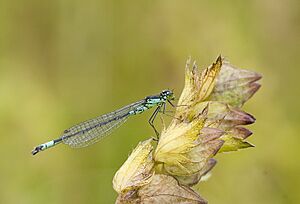Norfolk damselfly facts for kids
Quick facts for kids Norfolk damselfly |
|
|---|---|
 |
|
| Male C. armatum, Sweden. | |
| Conservation status | |
| Scientific classification |
The Norfolk damselfly is a small, blue insect. It is also known as the dark bluet. This type of damselfly lives in parts of Europe and Asia. It belongs to a family of insects called Coenagrionidae.
Contents
Why is it called the Norfolk Damselfly?
This damselfly got its name because it was first found in 1903. It was discovered in a small area called the Norfolk Broads in England.
How to Spot a Norfolk Damselfly
This damselfly looks a bit like other damselflies. For example, it might look like a blue-tailed damselfly. Both male and female Norfolk damselflies have a unique look. Their main body, called the abdomen, is mostly black. But it has bright colored parts at both ends. Male Norfolk damselflies have special parts at their tail end. These parts are very large and help tell them apart from similar damselflies.
Reproduction and Life Cycle
Norfolk damselflies like to breed in certain places. They choose ponds, ditches, and slow-moving rivers. These places need to have lots of water plants. The water also needs to be clean. This damselfly is very common in Northern and Eastern Europe.
We don't know a lot about how they reproduce. The female damselfly lays her eggs in the stems and leaves of water plants. The young damselflies, called larvae, live among these plants. They likely grow for about one year before becoming adult damselflies.
Behaviour of the Norfolk Damselfly
In Britain, these damselflies were seen from late May to late July. However, in Western Europe today, they fly earlier. They are most active in early May. Male damselflies often rest on floating leaves on the water. They are also strong flyers. This means they can fly quickly and cover good distances.
Where They Live and Their Status
You can find the Norfolk damselfly across a wide area. They live from Northern and Eastern Europe all the way to Siberia and Mongolia in Asia.
Norfolk Damselfly in Britain
The Norfolk damselfly used to breed in Britain. They were found in places like Sutton and Hickling Broads in Norfolk. The last time one was seen there was in 1968. Sadly, they disappeared from these British sites. This happened because the open water areas they needed slowly turned into dry reedbeds.
It was also thought that they had disappeared from the Netherlands. But, they were found again there in 1999. Since most Norfolk damselflies now live in the Baltic region and further east, it's unlikely they will return to Britain on their own. Because of this, people might need to help reintroduce them to Britain.


